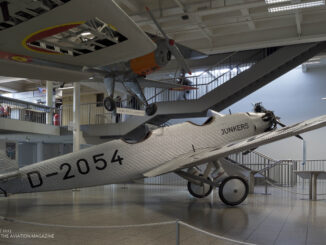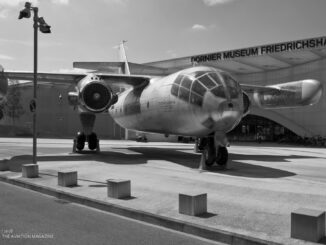
Poncelet (SABCA) Vivette (c/n 2, O-BAFH), exhibited in the aviation section of the Royal Museum of Armed Forces and Military History, Brussels, September 2023.
In 1920, Georges Néils – World War I aviation lieutenant and post-war commander of Haren aerodrome – established, with support of the highest Belgian authorities, a company named SABCA (Société Anonyme Belge de Constructions Aéronautiques – Belgian Company for Aeronautical Constructions). The company was aimed to support domestic aviation industry by designing and manufacturing its own aircraft.
At the beginning, main activities of the SABCA company were focused on aircraft maintenance services for the Belgian Air Force, as well as on building military aircraft under license. Nevertheless, the manufacturer encouraged its employees to create and build their own constructions. The first of such aeroplanes was SABCA Jullien SJ-1, designed in 1923 by Henri Jullien, chief engineer of the company.
In the same year, Paul Poncelet, head of the SABCA wood department, began with development of sailplanes. His first design, named SABCA Poncelet Castar and registered as O-BAFG, was a single seat motor glider. And actually, the first glider designed and built in Belgium.
Next, Poncelet redeveloped the Castar into a two-seat sailplane. Nevertheless, it should be pointed here that according to some sources, the initial design of both gliders was made by Mathieu Demonty, technical director of the SABCA company.
The second Poncelet´s glider was intended for Jean-Baptiste Richard – Belgian aviation pioneer and founder of the Saint-Hubert aerodrome. In October of 1923, the aircraft was officially registered as O-BAFH and named Vivette, after the Richard´s daughter.
The Vivette was an interesting construction, as the glider could be configured both as single and two-seat sailplane, as well as single seat motor glider. It was reported that the Vivette flew in all the three configurations mentioned above and, as the motor glider, was equipped with French Sergant A inline, air-cooled engine, generating 16-18 hp.
At the end of the year, the Vivette took part in Lympne Light Aircraft Trials in the United Kingdom. The aircraft successfully crossed the English Channel but failed to take part in the competition due to a minor accident during take-off. Flown by Baron Kervyn de Lettenhove, the Vivette touched the ground with tip of its wing and then turned upside down. Fortunately, the pilot was unhurt and the aircraft just slightly damaged.
In July of 1925, the Vivette, the Castar and another glider branded by the SABCA company – de Glymes Colanhan, O-BAFR, developed by Raoul de Glymes – took part in an aviation meeting in France. During the event the Vivette, configured as the conventional sailplane and flown by Major Albert Massaux of the Belgian armed forces, set the new flight endurance record in glider category.
Massaux managed to stay in the air for 10 hours 19 minutes and 43 seconds, beating the previous glider endurance record by more than four hours.
Regrettably, the Belgian team had no reasons to celebrate – earlier on that day, Victor Simonet who flew with the Castar, died in accident. A heavy rain forced Simonet to make an emergency landing, but he crashed after the fall from a height of forty metres. Moreover, on the same day, Lieutenant Maurice Damblon crashed the de Glymes Colanhan glider on the Normandy beach but survived the accident.
One year later, Jean-Baptiste Richard donated the glider to the Royal Museum of Armed Forces and Military History in Brussels, where it is being exhibited until today.



